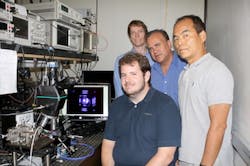Santa Barbara, CA--A group of researchers at University of California, Santa Barbara (UCSB) headed by famed blue-LED (and blue laser-diode) pioneer Shuji Nakamura has developed the first violet nonpolar vertical-cavity surface-emitting lasers (VCSELs) based on m-plane gallium nitride. The results could lead to short-wavelength laser diodes having higher optical efficiency and greatly reduced manufacturing costs.
“We have demonstrated working, electrically injected nonpolar m-plane nitride VCSELs lasing at room temperature, and have shown that such devices are naturally polarization-locked along the crystallographic a-direction of the wurtzite crystal,” says Daniel Feezell, project scientist with Nakamura’s lab. "This is in contrast to the majority of VCSELs, which are typically randomly polarized."
Feezell directed the research effort with Nakamura and Steven DenBaars, codirectors of the Solid State Lighting and Energy Center at UCSB, and graduate student Casey Holder. Their findings have been submitted for publication.
Inherently polarized VCSEL
“This is the first report of a nonpolar VCSEL, which we believe to be one of the biggest breakthroughs in the field of laser-diode technology,” explains Nakamura. “The nonpolar VCSEL has a lot of advantages in comparison with conventional c-plane devices. One major advantage is that the light polarization is locked to one direction. This device could be used for a variety of applications, such as lighting, displays, sensors, and technology that requires energy efficiency and small form factor.”
Laser Focus World readers are well-acquainted with the advantages VCSELs offer over conventional edge-emitting lasers for certain applications. VCSELs exhibit low threshold currents and circular and low divergence output beams, and VCSELs are easily integrated into 2D arrays. In addition, on-wafer testing of VCSEL arrays during their manufacture saves costs.
The nonpolar VCSEL platform also provides high optical gain, which helps to increase optical efficiency of devices. “The nonpolar VCSEL could enable new products and applications, such as picoprojectors for smartphones, mobile cinema, or even automotive lighting,” says DenBaars.
Shuji Nakamura is internationally recognized for developing blue, green, and white LEDs starting when he was at Nichia Corp. (Tokushima, Japan) in the early 1990s. He has been recognized for these advances with numerous awards, including the 2006 Millennium Technology Prize and a Technology & Engineering Emmy Award for pioneering the development of large-venue, large-screen color displays.
About the Author
John Wallace
Senior Technical Editor (1998-2022)
John Wallace was with Laser Focus World for nearly 25 years, retiring in late June 2022. He obtained a bachelor's degree in mechanical engineering and physics at Rutgers University and a master's in optical engineering at the University of Rochester. Before becoming an editor, John worked as an engineer at RCA, Exxon, Eastman Kodak, and GCA Corporation.

